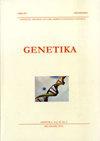Characterization of Pseudomonas syringae pv. morsprunorum originating from sweet cherry and plum in Serbia
4区 农林科学
Q3 Agricultural and Biological Sciences
引用次数: 0
Abstract
Pseudomonas strains originating from symptomatic (bacterial spot) leaf tissues of sweet cherry (Topola, Sumadija) and plum (Krusedol Selo, Srem) were isolated during 2016 and 2020, respectively. Based on the findings yielded by classical microbiological methods, LOPAT (+---+), GATTa (--++) and pathogenicity tests performed on detached fruitlets (sweet and sour cherry) and pods (bean pods), all strains were confirmed to belong to P. syringae pv. morsprunorum. The detection of cfl gene allowed strains that belong to race 1 to be identified. The DNA fingerprinting patterns obtained with four rep-PCR (BOX and ERIC), RAPD-PCR (M13), and IS50-PCR (IS50) methods revealed that the seven tested sweet cherry and plum P. s. pv. morsprunorum strains, as well as comparative KBNS71 and the reference strain CFBP 2119, were genetically heterogeneous. Conversely, MLSA based on the four-gene-based scheme (gapA, gltA, gyrB, and rpoD) indicated genetic homogeneity among all tested Serbian sweet cherry and plum strains, as well as P. s. pv. morsprunorum race 1 strains from the NCBI. Although the MLSA findings indicate that the sweet cherry and plum strains used in this study are 100% identical, as they might have different virulence genes, genome sequencing should be performed to eventually find the strain sub-clades based on the host.丁香假单胞菌的鉴定。原产于塞尔维亚的甜樱桃和李子
2016年和2020年分别从甜樱桃(Topola, Sumadija)和李子(Krusedol Selo, Srem)的症状性叶组织中分离到假单胞菌。根据经典微生物学方法LOPAT(+—+)、GATTa(—++)和离体果实(酸甜樱桃)和豆荚(豆荚)的致病性检测结果,所有菌株均属于丁香假单胞菌。morsprunorum。cfl基因的检测可以鉴定出属于1种的菌株。采用4种rep-PCR (BOX和ERIC)、RAPD-PCR (M13)和IS50- pcr (IS50)方法获得的DNA指纹图谱显示,7份检测的甜樱桃和李p.s. pv。该菌株与比较菌株KBNS71和对照菌株CFBP 2119具有遗传异质性。相反,基于四基因方案(gapA、gltA、gyrB和rpoD)的MLSA显示,所有测试的塞尔维亚甜樱桃和李子品系以及p.s. pv具有遗传同质性。来自NCBI的morsprunorum种族1菌株尽管MLSA研究结果表明,本研究中使用的甜樱桃和李子菌株是100%相同的,因为它们可能具有不同的毒力基因,但应该进行基因组测序以最终找到基于宿主的菌株亚分支。
本文章由计算机程序翻译,如有差异,请以英文原文为准。
求助全文
约1分钟内获得全文
求助全文
来源期刊

Genetika-Belgrade
AGRONOMY-GENETICS & HEREDITY
CiteScore
1.80
自引率
0.00%
发文量
1
审稿时长
6-12 weeks
期刊介绍:
The GENETIKA is dedicated to genetic studies of all organisms including genetics of microorganisms, plant genetics, animal genetics, human genetics, molecular genetics, genomics, functional genomics, plant and animal breeding, population and evolutionary genetics, mutagenesis and genotoxicology and biotechnology.
 求助内容:
求助内容: 应助结果提醒方式:
应助结果提醒方式:


